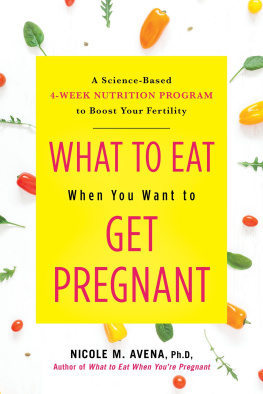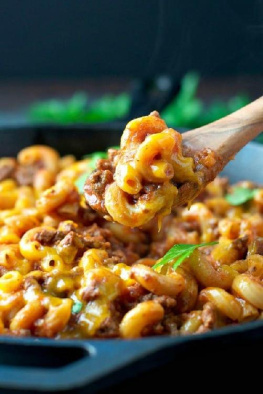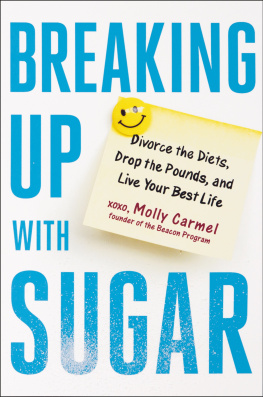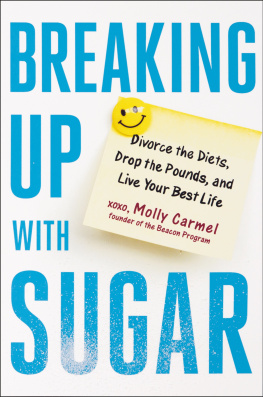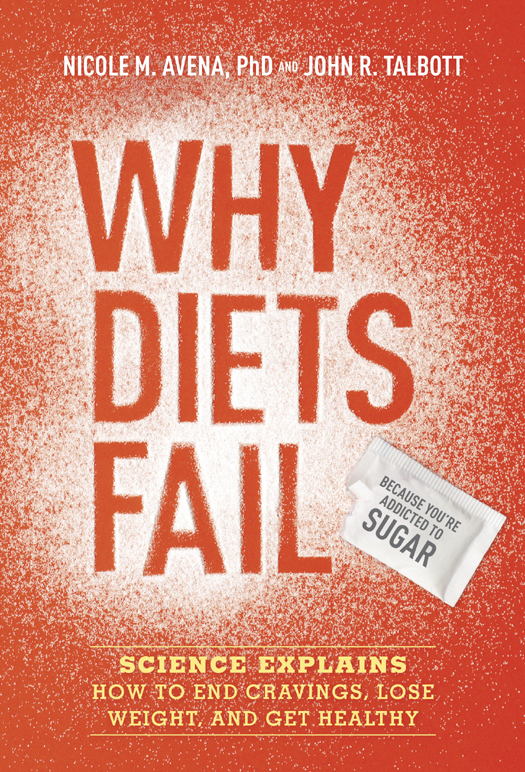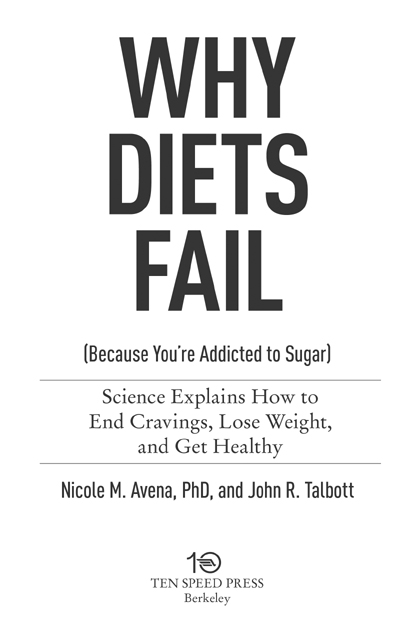Disclaimer: The information contained in this book is based on the experience and research of the authors. It is not intended as a substitute for consulting with your physician or other health-care provider. Any attempt to diagnose and treat an illness should be done under the direction of a health-care professional. The publisher and authors are not responsible for any adverse effects or consequences resulting from the use of any of the suggestions, preparations, or procedures discussed in this book.
Copyright 2014 by Dr. Nicole M. Avena and John R. Talbott
All rights reserved.
Published in the United States by Ten Speed Press, an imprint of the Crown
Publishing Group, a division of Random House LLC, a Penguin Random House
Company, New York.
www.crownpublishing.com
www.tenspeed.com
Ten Speed Press and the Ten Speed Press colophon are registered trademarks of Random House LLC
Library of Congress Cataloging-in-Publication Data
Avena, Nicole M., 1978
Why diets fail (because youre addicted to sugar) : science explains how to end cravings, lose weight, and get healthy / Nicole M. Avena, PhD. and John R. Talbott. First edition.
pages cm
1. Sugar-free diet. 2. SugarPhysiological effect. 3. Reducing diets. 4. Health.
I. Talbott, John R., 1955 II. Title. III. Title: Why diets fail (because you are addicted to sugar).
RM237.85.A94 2013
613.28332dc23
2013021488
Hardcover ISBN: 978-1-60774-486-3
eBook ISBN: 978-1-60774-487-0
Cover photography by Katie Newburn
Illustrations on .
v3.1
To SAB
NICOLE M. AVENA
To Gary Taubes
JOHN R. TALBOTT
Contents
PART ONEHOW SUGAR CAUSES YOU TO OVEREAT
STEP 1
Why Your Past Diet Attempts Have Failed
STEP 2
Weigh In on Your Sugar Intake
STEP 3
The New Science of Sugar Addiction
PART TWOHOW TO OVERCOME YOUR ADDICTION TO SUGAR
STEP 4
The Sugar Freedom Plan for Breaking Your Addiction
STEP 5
What to Eat and What Not to Eat
STEP 6
Managing Your Withdrawal
STEP 7
Managing Your Cravings
STEP 8
Avoiding a Relapse (and What to Do If One Occurs)
CONCLUSION
How to Maintain Your New, Addiction-Free Way of Eating
Acknowledgments
There are many important people to thank and acknowledge in the development of this book. We especially thank our editor, Julie Bennett, and the entire team at Ten Speed Press, as well as the folks at the Crown Publishing Group and Random House, for their assistance and support in the writing and development of this book.
Nicole M. Avena and John R. Talbott
I would like to thank all of my colleagues and collaborators for their research as well as the valuable information that they have produced in the fields of nutrition, neuroscience, and addiction. There are too many of you to name, but I value each of your unique contributions to our field. I would like to thank Bart Hoebel for his mentorship and friendship, and for getting me involved and excited about appetite research. I would also like to thank Susan Murray for her invaluable efforts assisting with the research, organization, and development of this book. She was there at every step along the way, and her interest in and enthusiasm for this project significantly contributed to the final product. I would also like to thank Cindy Kroll and Monica Gordillo for their assistance with researching various aspects of the contents in this book. In addition, I thank my friends and family for their help and support along the way. I am blessed to have an amazing network of loving and supportive friends. I especially thank Nicole, Nicki, Beth, and Marylynn for their encouragement while working on this project. I extend my gratitude to my parents and siblings (both the A team and the B team) for cheering me on. I also owe an infinite amount of thanks to my husband, Eamon. Youve supported me unrelentingly during this project, as well as all of the other little projects that I have concocted in life and work, which inevitably develop into something much, much bigger than anticipated. Your advice, levelheadedness, and comic relief provide the glue that keeps me together. Bert, thanks for staying up late with me all of those nights. Also, last but not least, thank you Stella for your patience and understanding and for allowing my work to temporarily encroach on our playtime. I love you all dearly.
Nicole
I would like to thank my friends and family who had to put up with my withdrawal symptoms when I went on this diet. Thanks especially to Teresa, who was an early guinea pig and who demonstrated that the diet really did make one feel dramatically better, more at ease, and more connected with life. I would like to thank Becky for her great job transcribing and proofing the book, Dottie for delivering on her promises as always, and Bill, Mario, Roberto, Tacho, Jacinto, Luis, and all the other usual suspects at K-38 for making the writing of this book as enjoyable as catching the perfect wave.
John R. Talbott
Introduction
Americans have more food to eat than any other people and more diets to keep them from eating it.
YOGI BERRA
Look around you. The vast majority of people in the United States are overweight, and a growing number are obese. Rich, poor, old, young, male, femalewe see obesity happening across all social domains, races, and ages. Body-weight problems arent restricted to certain groups of people. Right now, more than 60 percent of Americans are overweight, and more than 30 percent are obese. This is not just something that is occurring within the United States either; the obesity epidemic is a global problem.
Although many of us may want to lose weight simply to improve our appearance or how we feel about ourselves, there are important medical reasons for controlling body weight. Excess body weight has been associated with a number of health risks, including cancer, heart disease, and diabetes. Despite these potential harmful consequences and public health warnings regarding the dangers of obesity, many people continue to overeat. And this isnt hard to do. High-calorie, high-sugar food is easily accessible to many people today, and portion sizes have increased dramatically over the years. Food is also a big part of our social lives and, as you will read in later chapters, has taken on a new role in our society.
It didnt used to be this way. Fifty years ago, it was much less common to see fat people and usually a rarity to see fat children. So, what happened to cause such an abrupt and dramatic change in the waistline of society? Certainly, social factors made it easier to stay slim fifty years ago. There were more stay-at-home moms to prepare healthy, wholesome, homemade meals; more people smoked cigarettes (which are appetite suppressants); and, importantly, there werent as many food choices or the large portions we have today.


